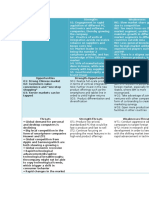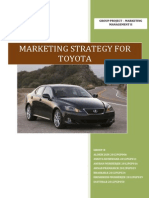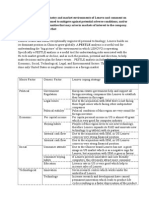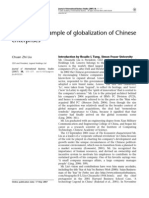Group 1 - Lenovo
Group 1 - Lenovo
Uploaded by
yatinsethi20062013Copyright:
Available Formats
Group 1 - Lenovo
Group 1 - Lenovo
Uploaded by
yatinsethi20062013Original Description:
Copyright
Available Formats
Share this document
Did you find this document useful?
Is this content inappropriate?
Copyright:
Available Formats
Group 1 - Lenovo
Group 1 - Lenovo
Uploaded by
yatinsethi20062013Copyright:
Available Formats
Lenovo: Strategic Effect of IT
ITSP End Term Project
2/16/2014
Group 1 Deepak Arora Nikhil Gurg Mohit Malik Neerav Sachdeva
Group 1/ITSP End Term Project 2014
Table of Contents
Timeline of Lenovo........................................................................................................................................ 3 Business Strategy .......................................................................................................................................... 3 Value Dimension of Lenovo .......................................................................................................................... 4 IT Strategy aligned to Business Strategy ....................................................................................................... 4 SWOT Analysis for Lenovo ............................................................................................................................ 6 Dynamic Resource Model ............................................................................................................................. 7 Mcfarlans Strategic grid ............................................................................................................................... 7 Porter 5 forces analysis ................................................................................................................................. 8 Balance Score Card for Lenovo ..................................................................................................................... 9 Creating Strategy Map .............................................................................................................................. 9 Creating Scorecard Measures ................................................................................................................. 13 Benefits of Acquisition of ThinkPad ............................................................................................................ 17 Conclusion and Recommendations ............................................................................................................ 17 References .................................................................................................................................................. 17
2|Page
Group 1/ITSP End Term Project 2014
Timeline of Lenovo
History of Lenovo:1984 The Lenovo was established in 1984, with an initial capital outlay of only RMB200,000. 1986 Backward integration and forward integration 1990- The very first Legend PC is launched in the market. 1996:-Legend becomes the market share leader in China for the first time. 2002-Lenovo acquired technologies from Microsoft, Acquisitioned the many middle and small size PC companies in China. 2005- It successfully acquisitioned of IBM, making it a new international IT competitor and the thirdlargest personal computer company in the world. 2012-Dropped the IBM tag what next for Lenovo????? What Lenovo Says Personal Computers: Lead in PCs and be respected for our product innovation and quality. Convergence: Lead the industry with an ecosystem of devices, services, applications and content for people to seamlessly connect to people and web content. Culture: Become recognized as one of the best, most trusted and most well-respected companies to work for and do business with.
Business Strategy
Business model built on innovation, operational efficiency and investment in emerging markets. Sustaining a Competitive Advantage:-By increasing market share internationally through innovation and strategic acquisitions. Protect and Attack Strategy Initial Challenges Faced By Lenovo Lenovo has failed to meet a key objective of the merger: leveraging the combined strength of the two companies to grow volume and market share. To generate the demand through more aggressive sales teams. To improve the channel strategy. Increased market spending and better execution outside of China.
3|Page
Group 1/ITSP End Term Project 2014 What Transform the Lenovos Business? Disintermediation (cutting out the middleman):- JDA Software's E-commerce Application Enhancing customer value :- Unique distribution strategy Process and operations innovation: ThinkLink Application Let data do the driving :- SAP BI/DW IQ
Value Dimension of Lenovo
Operation Excellence Business Context What: More competitive pricing to customers How: Customer satisfaction and innovation so that they can give competitive pricing. Why: To grow market share and compete with other top 2 players HP and Dell Business Capabilities needed Information and tools for Managers so that they can align the strategy globally. Integrated systems so that they can use the information and deliver the quality and service consistent. Investments for R/D so that they can cut down the costs.
IT Contribution Innovation and 5 R/d Centres Globally
Business Intelligence Tool SAP BI/DW IQ tool Distribution network and effective supply chain tools
IT Strategy aligned to Business Strategy
Innovation Strategy ThinkPad T42 Innovation: - Field agents to receive new case information packets and provide case status updates via the Internet. Scanned files are now uploaded into a searchable database that any authorized user can access from the offices or remotely through a Virtual Private Network connection. It saves huge amount of costs.
4|Page
Group 1/ITSP End Term Project 2014 ThinkCentre A50 Innovation:- Employee to access client databases from their own desktop. So no physical access. Rescue and Recovery Innovation :- protect users' data, allowing them to recover deleted or lost files, folders
Operations Excellence ThinkVantage Technologies IT infrastructure:-reduction in overtime, IT service costs and increased business efficiencies. CSAT System:-Information Management and The Customer Satisfaction index numbers to check customer satisfaction. Distribution Network In house manufacturing specialization. JDA Agile Business Process Platform (ABPP) extremely configured order process end-to-end customer service value chain Advanced pricing structures such as volume-based and special customer discounts, promotions and other assorted pricing adjustments. Protect and Attack Strategy Keep the business strategy align globally A Business Simulation Builds Execution Capabilities: - Simulator application to build its leader. BTS Lenovo on a tailored business simulation designed to develop the execution capabilities of high level leaders across global locations Deploying in the cloud: - JDA and SAP BI/DW IQ JDA Cloud Services, Lenovo has achieved faster deployment, rapid time to value, investment protection and an improved cost structure DA Cloud Services to optimize the Web commerce solution based on feedback it receives from its customers
5|Page
Group 1/ITSP End Term Project 2014
SWOT Analysis for Lenovo
Strengths Vertical Integration: Helps in keeping cost low and control inventory. Low Cost Production: It manufactures nearly half of its hardware and has set up its production plants in low cost region such as china, Brazil and Argentina to benefit from higher margins. Strong Patents portfolio : With acquisitions of Compaq, IBM etc and firms R&D, it has gathered important patent portfolio related to its PC and Software business Competency in Mergers and Acquisitions Synergy of knowledge and diverse workforce: Instead of traditional headquarter model, it manages 3 centers of excellence US, China and Singapore. Combining different skills and resources results in synergy and premium quality products
Weakness Poor brand perception in developed economies like US and European countries Focus earlier mainly on china, Limited Knowledge of global market Low Differentiation: Lenovo products are little differentiated from competitors products and are in competitive disadvantage if the price offered by competitor is lower. Market share growth is Slow due to competition, fake products/imitations affects sales
Opportunities Growing Indias Smartphone market Growth of Tablet Market: Lenovo is 4th largest tablet seller, it could increase its market share by introducing better quality products. Internet boom - Increase in demand of PCs Government organizations increasing their spending on IT
Threats Profit margin decline on hardware products: Lenovo major source of income is from hardware products, due to rising raw material cost and competition, profit margin will shrink in future. Saturated Smartphone market in developed countries Intense competition Price wars Fake products market
6|Page
Group 1/ITSP End Term Project 2014
Dynamic Resource Model
Dynamic Resource Model
IT Infrastructure-App, Innovation ,Supply chain and In house manufacturing specilaization
Resources for advantage
Start
Initial Advantage
Sustainable advantage
Inefficient legacy IBM infrastructure to the JDA platform. JDA Software's Web commerce solution. Distribution network and supply chain applications
Cost +Innovation, BTS simulation App-Global aligned strategy IBM brand name and IBM resources R/D centres Think lInks Apps SAP BI/DW IQ App
Reinvestment in R/D
Mcfarlans Strategic grid
This grid will help in evaluating where does and will IT give added value . Use of IT is of strategic importance for Lenovo as these are critical to future success, use of IT has led to disintermediation of middlemen, reduction in service costs, improving supply chain, vertical integration, and CSAT systems to measure customer satisfaction and provide better customer value. All these benefits of IT had helped Lenovo in providing better customer value.
7|Page
Group 1/ITSP End Term Project 2014
Factory
Strategic Lenovo
Support
Turnaround
X axis: Impact on Strategy Y axis: Impact on Business operations
Porter 5 forces analysis
Threat from existing competition Very High Large number of players in the market Dell, HP, Apple, Sony, Samsung etc
Threats from new entrants Low Vertical integration of existing players leading to high switching costs Huge initial investments Difficult to achieve economies of scale to be competitive
Bargaining Power of Suppliers- low Lenovo manufactures its own material to great degree Large number of suppliers in the market
Bargaining power of buyers low to moderate High switching cost - Main customers are enterprises, which purchases in bulk Improving product and service quality, offering extra feature and maintaining strong customer relationship is key to success
8|Page
Group 1/ITSP End Term Project 2014
Threats from Substitute products medium Products like ultra-light laptop and ultra-mobile PCs attract young customers and affects B2C sales In case of B2B, enterprise dont see them as useful to organization
Balance Score Card for Lenovo
Balance Score Card has been one of the main features of IT strategy implemented by Lenovo. It has been one of the strategic initiatives of the organization where not only the financial health of the firm but also the intangible assets like supply chain partnership, delivery goodwill can also be mapped and valuated. Secondly it has been of great help in terms of communicating the IT and Business strategy of the firm both internally and externally. Thirdly, it helped the company into streamlining its activity with its strategy and thus leading to acquisition of ThinkPad division from IBM. Finally, it has become one of the strategic advantages for the company as it has been implemented into many other divisions for performance Evaluations. The balance Scorecard for Lenovo is developed as following, 1. Strategy Mapping 2. Creating Scorecard Measures 3. Implementing Scorecard
Creating Strategy Map
It is a generic architecture for describing strategy followed by an organization. The strategy Map for Lenovo is as following,
9|Page
Group 1/ITSP End Term Project 2014
STRATEGY MAP
It defines the Mission, Vision, Business Strategy and the effects of four perspectives of balance scorecard are as following to obtain the output for business strategy. The following four images describe how the business strategy can be obtained using the four perspective of the balance score card. The skill development among employees will lead to integration of leading edge manufacturing of various Lenovo products which will lead to reduction in cost and time to delivery and maintenance. This will further help in generating more orders for the company and effectively supply quality products and service through use of IT and learning. Similarly for other images also.
10 | P a g e
Group 1/ITSP End Term Project 2014
11 | P a g e
Group 1/ITSP End Term Project 2014
12 | P a g e
Group 1/ITSP End Term Project 2014
Once the strategy mapping has been made, it is well defined for making the balance scorecard as strategy mapping is basically a blueprint which defines the pathway from each perspective to finally obtaining business strategy.
Creating Scorecard Measures
The scorecard consist of four perspectives, 1. 2. 3. 4. Financial Customer Internal Process Learning and Growth
For each of the perspective objectives are defined and for each objective there can be various measures to check if that objective has been completed or not. Each measure consists of one to one mapping with a specific target. Each of which can be obtained through various initiatives. The four perspective, their objective, measure, target and initiatives are as following,
A) Financial Perspective
Objective Measure Target Initiative
Broaden Revenue Mix
% of order from various BU
XX% BU1 XX% BU2
1. Generate Awareness of Brand. 2. Provide Innovative Solution to customers. 3. Public success stories in media.
1. ROE Increase shareholder value 2. Cost Reduction in each BU
3. Save managed cost and unused capacity. 4. Save direct material and labor cost through IT
13 | P a g e
Group 1/ITSP End Term Project 2014
1. % market Share Technology and Market Leader 2. No of Innovative products and services 3. % of green products
1. Reach X% market share 2. 2-2 major products of each BU 3. X% reduction in next FY 2014
4. Increase the models and types.
B) Customer Perspective
Objective
Measure
Target
Initiative
Develop new technology space
1. No of innovations made. 2. New SCA resources found
1. X% increase in innovations 2. Milestone achieved in SCA resources
1. Collaboration with institutes and Universities. 2. Leveraging Information Expert Systems 3. Increase customer focus of sales organization. 4. Efficient Supply chain system for Retention and Responsiveness
Increase Customer Satisfaction
Customer Satisfaction Survey
Attain X% customer satisfaction
Customer Retention
1. No of collaboration with partners. 2. Sales Discounts
3. X% Discount Budget 4. X% market Vertical penetration.
14 | P a g e
Group 1/ITSP End Term Project 2014
Responsiveness to Customer
Delivery in time
X% reduce in complaints
C) Internal Process Perspective
Objective
Measure
Target
Initiative
Timely provide safe and Quality Products
1. Improve manufacturing capacity 2. Supplier Ratings for quality
3. Reduce cycle time by X%. 4. Lowest 10% supplier rejected.
5. Organize R%D teams for future projects. 6. Implement Design Commonality for standardizatio n. 7. Internal Surveys for improving manufacturin g capacity. 8. Effective supply chain management.
Increase productive efficiency at low cost
Training Cost for Manufacturing Floor Crew
X week training per quarter
Standardization of Services
Inventory Cost Reduction
X% reduction by next FY
Increase IT Portfolio
Number of Discovery and Portfolio Investments
X number of projects initiated
15 | P a g e
Group 1/ITSP End Term Project 2014
D) Learning and Growth Perspective
Objective
Measure
Target
Initiative
Employee education and skill level
1. No of training hours per annum. 2. Employee skill assessment.
3. At least X% training hours. 4. Cross training of management and technical knowledge
5. Hire Key Technical Employees. 6. Improve Employee skills and work conditions. 7. Celebrate and reward individuals. 8. Tie incentives to idea and qualities. 9. Mentorship programs.
Employee satisfaction scores
Employee Satisfaction Surveys
Achieve more than X% in FY
Knowledge management systems
No of idea created and published in system
At least X number per annum
Diversified Workforce
Number of cultural activities occurred
Achieve X activity per month.
Thus above was the entire balance score card for Lenovo.
16 | P a g e
Group 1/ITSP End Term Project 2014
Benefits of Acquisition of ThinkPad
Learning new methodologies and better business processes Getting access to new markets Increase in market share Making use of past data for making better informed decisions
Conclusion and Recommendations
Use data mining to reduce the process turnaround time for higher efficiency. Timely review of IT applications to monitor their use and effectiveness in the current scenario and make necessary changes as per requirement. Integrate business process and IT applications in vertical acquisition or vertical supply chain.
References
http://www.lenovo.com/in/en/ http://en.wikipedia.org/wiki/Lenovo http://en.wikipedia.org/wiki/ThinkPad http://news.lenovo.com/article_display.cfm?article_id=1755 http://www.bbc.co.uk/news/business-25956864 http://www.computerworld.com/s/article/9245907/Lenovo_s_Motorola_IBM_server_buys_will_likely_ get_strict_U.S._security_review http://www.fool.com/investing/general/2014/01/27/why-lenovo-is-buying-ibms-server-business.aspx
http://www.china.org.cn/english/NM-e/115844.htm
17 | P a g e
You might also like
- Lenovo Strategic Managment AnalysisDocument3 pagesLenovo Strategic Managment AnalysisAkhil Bangia100% (4)
- Space Matrix BMWDocument4 pagesSpace Matrix BMWmadalus123No ratings yet
- SWOT-ToWS Analysis of LenovoDocument2 pagesSWOT-ToWS Analysis of Lenovoada9ablao100% (4)
- The Strategic Marketing Management Analysis of Lenovo GroupDocument7 pagesThe Strategic Marketing Management Analysis of Lenovo GroupcinemecamNo ratings yet
- Case Study LenovoDocument10 pagesCase Study LenovoGOHAR GHAFFARNo ratings yet
- External AssessmentDocument13 pagesExternal AssessmentZainab Saleem100% (1)
- Lenovo Group LTDDocument22 pagesLenovo Group LTDZulLC InfoTech100% (1)
- LenovoDocument33 pagesLenovoIshant Kathuria100% (2)
- Lenovo Case Study PDFDocument16 pagesLenovo Case Study PDFAngel Portosa67% (3)
- Assignment 2 International Business PlanDocument5 pagesAssignment 2 International Business PlanEthiria Cera FaithNo ratings yet
- Lenovo Case StudyDocument3 pagesLenovo Case StudyKyaw KyawNo ratings yet
- Toyota Marketing StrategyDocument2 pagesToyota Marketing StrategySavitha Bhaskaran100% (1)
- Ibm LenovoDocument34 pagesIbm LenovoPrateek Gupta100% (1)
- Group 1 LenovoDocument17 pagesGroup 1 LenovoGULAM GOUSHNo ratings yet
- Lenovo Internal AuditDocument36 pagesLenovo Internal AuditDikaNo ratings yet
- Swot Analysis of LenovoDocument2 pagesSwot Analysis of LenovoSuyash ShuklaNo ratings yet
- Lenovo Case AnalysisDocument4 pagesLenovo Case AnalysisYasmin Gloria100% (1)
- Strategic Planning For LENOVO: North South UniversityDocument43 pagesStrategic Planning For LENOVO: North South UniversitycykablyatNo ratings yet
- Swot Analysis LenovoDocument11 pagesSwot Analysis LenovoZahid Bhat100% (1)
- Lenovo Swot AnalysisDocument3 pagesLenovo Swot Analysismukulbabbar100% (2)
- Ansoff's MatrixDocument6 pagesAnsoff's MatrixSharif MahmudNo ratings yet
- Compiled Case Study-LenovoDocument24 pagesCompiled Case Study-LenovoHowell Yap100% (2)
- The Nature of Strategy Implementation Marketing, Finance Accounting, R&D and MIS IssuesDocument12 pagesThe Nature of Strategy Implementation Marketing, Finance Accounting, R&D and MIS Issues'Jordi Angka50% (2)
- Marketing Midterm - Mohamed Serageldin - PEPSIDocument14 pagesMarketing Midterm - Mohamed Serageldin - PEPSIHossam SamyNo ratings yet
- Lenovo BSGDocument7 pagesLenovo BSGNiaz Khan100% (1)
- Diversification in The Context of Growth StrategiesDocument10 pagesDiversification in The Context of Growth StrategieskavenNo ratings yet
- Apple StramaDocument23 pagesApple StramamariadaniellecuysonNo ratings yet
- Lenovo Case PDFDocument30 pagesLenovo Case PDFDahniar Amalina100% (1)
- Strategic Analysis of Case StudyDocument14 pagesStrategic Analysis of Case StudySyed Bilal Ali ShahNo ratings yet
- LenovoDocument84 pagesLenovoasifanis100% (1)
- Abstract ZyngaDocument60 pagesAbstract Zyngaingrid100% (2)
- Case 3Document3 pagesCase 3Chryzbryth LorenzoNo ratings yet
- Competitive Position AnalysisDocument14 pagesCompetitive Position AnalysisYashraj PatilNo ratings yet
- Porters Five Forces Analysis Is A Framework For Industry Analysis and Business Strategy Development Formed by Michael EDocument2 pagesPorters Five Forces Analysis Is A Framework For Industry Analysis and Business Strategy Development Formed by Michael EManish Khanal100% (2)
- Solution Manual For OM 4 4th Edition by CollierDocument15 pagesSolution Manual For OM 4 4th Edition by CollierNonoyArendainNo ratings yet
- MBM 5207, Strategic MGT NotesDocument40 pagesMBM 5207, Strategic MGT NotesMunyentwari PaulNo ratings yet
- IBM Case StudyDocument21 pagesIBM Case StudyFathi Salem Mohammed Abdullah70% (10)
- Strategic ManagementDocument4 pagesStrategic ManagementA CNo ratings yet
- Case - Hyundai IbDocument6 pagesCase - Hyundai IbmallikaNo ratings yet
- Topic1 BE Changing Environment and Stakeholder ManagementDocument14 pagesTopic1 BE Changing Environment and Stakeholder ManagementJeevan Nath100% (1)
- Chapter 02 Powerpoint - Strategic ManagementDocument16 pagesChapter 02 Powerpoint - Strategic Managementlilly_teixeiraNo ratings yet
- Strategic ManagementDocument75 pagesStrategic ManagementGaurav SonkeshariyaNo ratings yet
- Executive SummaryDocument18 pagesExecutive SummaryDeepak RawatNo ratings yet
- Pest Analysis Coca ColaDocument2 pagesPest Analysis Coca ColaNocQuisaotNo ratings yet
- Johnson & Johnson Business Case Slides - Robert W. Campbell AwardDocument17 pagesJohnson & Johnson Business Case Slides - Robert W. Campbell AwardNSCFacultyPortalNo ratings yet
- SwotDocument4 pagesSwotromitguptaNo ratings yet
- MKT306 Marketing Strategy Assignment - Gajanath - AnswerDocument16 pagesMKT306 Marketing Strategy Assignment - Gajanath - AnswerBalachandrarajan KarthikNo ratings yet
- Ford Strama FinalDocument33 pagesFord Strama FinalAnonymous MCtN3Fm75% (4)
- Strategic MGMT Lec Quiz 6Document3 pagesStrategic MGMT Lec Quiz 6Wennie NgNo ratings yet
- Strategic Management Assignment 3Document14 pagesStrategic Management Assignment 3Djimajor Robert TettehNo ratings yet
- Consumer Behavior Study On Jus and Jerry'sDocument38 pagesConsumer Behavior Study On Jus and Jerry'sDarwyn MendozaNo ratings yet
- LenovoGlobalBrandCaseAnalysis 083015Document16 pagesLenovoGlobalBrandCaseAnalysis 083015Yu Nathaniel Kang100% (1)
- Competitive Strategy Notes at MBADocument26 pagesCompetitive Strategy Notes at MBABabasab Patil (Karrisatte)No ratings yet
- Submitted By: Talha Daud Roll No: 38 BBA 7 Question No.1Document1 pageSubmitted By: Talha Daud Roll No: 38 BBA 7 Question No.1talhaNo ratings yet
- StramaDocument371 pagesStramaJanine ManzanoNo ratings yet
- Group Facebook Case Study 2 AnswerDocument10 pagesGroup Facebook Case Study 2 AnswerNCTNo ratings yet
- Opeman Regis (March 2015)Document23 pagesOpeman Regis (March 2015)Ann Garrido-AcevedaNo ratings yet
- Value Chain Management Capability A Complete Guide - 2020 EditionFrom EverandValue Chain Management Capability A Complete Guide - 2020 EditionNo ratings yet
- Information Systems For Organizations and GlobalizationDocument33 pagesInformation Systems For Organizations and GlobalizationGavindu TharakaNo ratings yet
- Case CadburyDocument10 pagesCase Cadburyyatinsethi20062013No ratings yet
- Exercise - 1 (Discriminant Analysis)Document1 pageExercise - 1 (Discriminant Analysis)yatinsethi20062013No ratings yet
- KKHS, Homework Class 9Document65 pagesKKHS, Homework Class 9yatinsethi20062013No ratings yet
- Post Graduate Diploma in Management (FMG-21) (2013-2014) Schedule of Summer Project PresentationsDocument4 pagesPost Graduate Diploma in Management (FMG-21) (2013-2014) Schedule of Summer Project Presentationsyatinsethi20062013No ratings yet
- Apple Incorporation (Case Analysis) : College of AccountancyDocument54 pagesApple Incorporation (Case Analysis) : College of AccountancybeeeeeeNo ratings yet
- Strategic Marketing Assignment KitDocument22 pagesStrategic Marketing Assignment KitAbood Thekrallah100% (1)
- Lenovo An Example of Globalization of ChineseDocument5 pagesLenovo An Example of Globalization of ChinesehussamkarNo ratings yet
- Lenovo Group Final ProjectDocument29 pagesLenovo Group Final Projectapi-519588807No ratings yet
- IBM ProfileDocument6 pagesIBM ProfilethejaswibgowdaNo ratings yet
- Lenovo Z370 Specs PDFDocument1 pageLenovo Z370 Specs PDFjohnrey_lidresNo ratings yet
- Computers: Lenovo - Lenovo V145-14AST: 81MSDocument2 pagesComputers: Lenovo - Lenovo V145-14AST: 81MSTam BleinNo ratings yet
- Laptop Industry Final ReportDocument7 pagesLaptop Industry Final Reportapi-700918564No ratings yet
- r400 and r500 DatasheetDocument4 pagesr400 and r500 DatasheetNuril Anwar SyafrudinNo ratings yet
- Microeconomics AssignmentDocument11 pagesMicroeconomics AssignmentHazim YusoffNo ratings yet
- Psref502 PDFDocument463 pagesPsref502 PDFskyNo ratings yet
- Dell in India Targeting SMB Markets - The Differentiation Strategy PDFDocument16 pagesDell in India Targeting SMB Markets - The Differentiation Strategy PDFJatinNo ratings yet
- Market and MarketingDocument32 pagesMarket and Marketinganup patilNo ratings yet
- Cloud Pak For Data System Certification PathDocument15 pagesCloud Pak For Data System Certification PathElmer Ronald Vargas CartagenaNo ratings yet
- Rescue and Smart Assistant User GuideDocument51 pagesRescue and Smart Assistant User GuideRusbel Estrada RamirezNo ratings yet
- Gec 2016 2017 Updated - 013118Document34 pagesGec 2016 2017 Updated - 013118MLB AccountNo ratings yet
- Lenovo Bios Setup Linux Wmi Sysfs 1.2Document11 pagesLenovo Bios Setup Linux Wmi Sysfs 1.2Felipe DuarteNo ratings yet
- List of Mobile Phone Makers by Country - Wikipedia PDFDocument9 pagesList of Mobile Phone Makers by Country - Wikipedia PDFTharaka PereraNo ratings yet
- Google Motorola AcquisitionDocument26 pagesGoogle Motorola AcquisitionSharwani PawarNo ratings yet
- CSR Activities of Some CompaniesDocument46 pagesCSR Activities of Some Companiesprateek678100% (1)
- Lenovo Thinkpad x201Document278 pagesLenovo Thinkpad x201Anonymous TEXHPC2zSNo ratings yet
- DELLivering Progress FinalDocument9 pagesDELLivering Progress FinalHimanshuNo ratings yet
- PCWorldDec 07Document194 pagesPCWorldDec 07lora100% (5)
- cIM Assignment Cover Sheet: Grade: /20Document7 pagescIM Assignment Cover Sheet: Grade: /20AryanSinghNo ratings yet
- Lenovo "Peace of Mind" Offer Terms & Conditions: WWW - Lenovowarranty.inDocument2 pagesLenovo "Peace of Mind" Offer Terms & Conditions: WWW - Lenovowarranty.inshyambtech@No ratings yet
- Technology Management SyllabusDocument8 pagesTechnology Management SyllabusEugene D NapsterNo ratings yet
- Drivers and SoftwareDocument3 pagesDrivers and SoftwareArjit GuptaNo ratings yet
- Compiled Case Study-LenovoDocument24 pagesCompiled Case Study-LenovoHowell Yap100% (2)



























































































